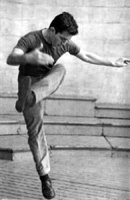
|
Folk Dance Federation of California, South, Inc.
|

|
CLICK IMAGE TO ENLARGE
Of late there has been much talk as to how international folk dancing has taken a sudden drop. Even in California, which appeared to have had a lasting effect, there have been misgivings about the general folk dance condition. There have been many speculations, and many discussions, and even some energetic efforts to try to revive interest. But such movements cannot be mechanically recreated and the impulse has to flow naturally; no doubt in time there will once again be a revival in folk dance.
We all have had our own interpretation, and having been involved with the Intersection for over 20 years, I have my own reasons as well. The cry is, "What to do, what to do?" We all have to move ahead and go on with our own guided interest and diligently pursue it because we love it and because it gives something in return. After all, we never got involved in it because of the numbers anyway.
One apparent evolution that appears to be taking place is that there seems to be a growing interest among young people in the ethnic communities, that did not pay as much attention to their cultural roots before, are beginning to slowly bend towards reviving the folklore of their heritage.
I have seen, in my efforts over the years, how I could excite Greeks in showing any concern beyond the two or three common dances they knew at their festivals; they now are beginning to be more concerned about learning dances from various provinces, the Greek islands, and of course, making sure that they also have the appropriate attire.
Though the interest in folk dance seems to be waning in the general sense, there is a growing need for young people to associate themselves with the cultural heritage of their ancestors. It may be then that those of us who have been involved in folk dance might take a clue and find a way to re-associate ourselves with the various ethnic groups, because it is becoming more and more apparent in practically every major city that ethnic pride is being promoted by city fathers.
It is evident that folk dancing is not dying, but rather going through a transformation. In the last couple of years at the Intersection, I could not see the different direction that I needed to take, but only that a new direction was evident. Now I see that the emerging interest in the Greek communities is one way in which folk dance will have another glorious new day.
Soon in California, as they have for the last ten years, over two thousand dancers will emerge and compete for various medals in a festival that lasts for three days. this kind of growing interest cannot be dismissed by the folk dance community at large. What we all have to understand is that folk dance is what all are committed to, and need to find ways to revive it. The Greek communities today are thriving, better than ever before, and those who have been involved know why it has happened. The important thing is that it is there and alive, better than ever, and a renaissance is awaiting the movement all over again.
The California Greek youth movement is on its way to becoming a national institution, and despite shortcomings of focusing on competition, the immense energy, goodwill, and enthusiasm that it generates can be seen as a clue that folk dancing is alive and doing well among young and old.
Reprinted from "Greek Dance Thrives" by Athan Karras
Viltis Magazine, May 1986, Volume 45, Number 1, V. F. Beliajus, Editor.